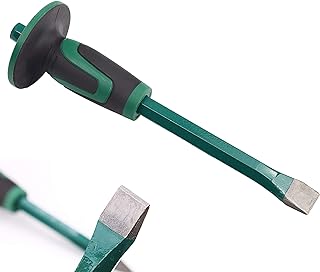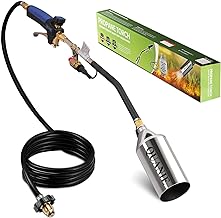5 important factors worth considering when looking for the best chisel for rocks
Choosing the best chisel for working with rocks is an important decision that can greatly impact the success of your projects. Factors like the type of rock, the material of the chisel, and its design all play a role in how well you can work and how your projects turn out. By carefully considering these things, you can improve the quality of your work and make working with rocks more enjoyable. Your project’s outcome can greatly benefit from choosing the right chisel, so it’s important to make informed decisions based on these key factors.
See our guide to the best chisel for rocks.
Material quality
When choosing a chisel for working with rocks, it’s important to consider the quality of the material. A chisel made from high-quality steel or tungsten carbide can greatly improve your efficiency and precision. These superior materials make the chisel more durable and keep it sharp longer, making it easier to cut through tough rocks. While a chisel made from top-notch materials may cost more upfront, the long-term benefits in performance and longevity make it worthwhile for rock enthusiasts or professionals.
The material of the chisel affects its resistance to wear and tear, which impacts its ability to withstand the demands of rock carving. Lower quality materials can chip, dull, or break during heavy use, slowing down your progress and creating safety risks. By prioritizing material quality when choosing a chisel for rocks, you are not just getting a tool, but an asset that allows you to achieve intricate details and smooth finishes with confidence. Essentially, the material quality of a chisel is crucial for its performance, influencing the success and satisfaction you experience in your rock carving projects.
Blade size and shape
Choosing the right chisel for working with rocks is important for your success and satisfaction. The size and shape of the blade are key factors to consider.
A wider blade is good for removing large chunks of rock quickly, while a narrower blade is better for detailed work on smaller rocks. Consider the type of rock you’re working with and the tasks you need to do when choosing the blade size and shape.
The shape of the blade also matters. A flat blade is good for making clean lines, while a pointed blade is better for precise shaping. Using a combination of blade shapes can help you tackle different rock carving projects.
Ultimately, the best blade size and shape for your chisel depend on your preferences, the complexity of the tasks, and your skill level in rock sculpting.
Handle design and comfort
When choosing a chisel for cutting rocks, the design and comfort of the handle are important for a better user experience. The handle connects the person to the tool, influencing how well they can control and be precise while cutting. A well-made handle that fits the hand well can reduce fatigue and allow for longer work periods with accurate results. A handle that is ergonomically designed not only makes gripping easier, but also reduces the risk of hand strain or blisters, helping users focus on their work without distractions.
Having a chisel with a well-designed handle is not just about comfort, but also about improving efficiency and productivity when working with rocks. A handle that feels natural to hold and provides good support can greatly enhance cutting technique and overall performance. A comfortable handle can give users confidence and control, making it easier to handle tough rock cutting projects accurately. In the end, the handle of a chisel should be seen as more than just a functional part, but as a crucial element that can enhance the entire rock cutting experience.
Durability
When you’re looking for a chisel to use on rocks, it’s important to think about how long it will last. A strong and tough chisel can make a big difference in whether it can keep going for a long time or if it breaks easily when you’re working with tough materials. The durability of the chisel is really important because it affects how well and how quickly you can work on shaping rocks. Choosing a chisel made of good materials that can handle being used a lot is like investing in your craft, making sure you have a reliable tool for your rock-carving adventures for many years.
Picking a durable chisel is more than just finding one that can handle being used a lot; it shows how serious you are about your craft. A chisel that can handle the challenges of tough rocks and rough places shows how dedicated you are to your art. It feels really good to use a reliable chisel as you work on shaping rocks, giving you confidence and making you feel strong in your skills. Make durability your top priority when picking a chisel for rocks, and see how your creations come together with accuracy and skill, supported by a tool that shares your commitment to doing great work.
Price and budget
When choosing chisels for rock carving, it’s important to find a good balance between cost and quality. High-quality chisels can make a big difference in how your rock carving turns out, allowing you to create precise and detailed work for the best results. While it might be tempting to go for the cheapest option, investing in better-quality chisels can save you time and frustration in the long term. More expensive chisels are often more durable and sharper, making carving easier and more efficient, which is worth it for serious rock carving enthusiasts.
However, you should also think practically when deciding which chisels to buy. It’s important to set a budget that fits your needs and how often you’ll be carving to avoid spending too much on features you don’t really need. Prioritizing quality over a low price is key to getting a chisel that can handle the demands of rock carving. By finding the right balance between cost and quality, you can have a more enjoyable and successful rock carving experience.
Conclusion
In summary, chisels are important tools for working with rocks because they provide accuracy and control needed to shape and sculpt stone. Using a chisel takes practice and patience, but the outcomes are amazing. Whether you are a professional stonemason or just enjoy working with rocks as a hobby, the chisel is a classic tool that allows for creativity and artistic expression in the world of rocks and minerals. Want more info on duster, check the best duster.


